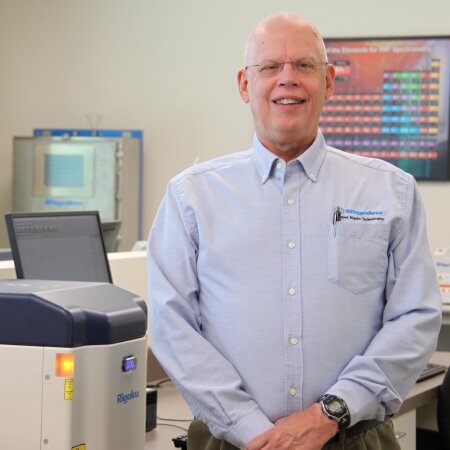Application Note EDXRF3142

Scope
The analysis of coal fly ash is demonstrated using NEX CG II, an indirect excitation EDXRF analyzer featuring a Cartesian Geometry optical kernel that employs polarized excitation from secondary targets.
Background
Coal is a rich source of energy and is combusted to produce heat. Coal-fired power plants use this energy to produce electricity. During combustion, two types of ash are formed. The heavier ash collects at the bottom of the boiler with the boiler slag, while the lighter fly ash escapes up the exhaust stacks with the volatile flue gasses as a fine powder and is collected by various means. Fly ash is rich in several important elements and has many beneficial uses. Its main use is as a major component of cement and concrete, as well as fill material for asphalt and roads.
Fly ash is the main component of eco-friendly green cement, producing a strong, long-lasting cement with a lower carbon footprint than traditional Portland cement.
Additionally, coal ash is also used to enhance soil quality, improving drainage and adding nutrients to the soil.
Coal fly ash may contain trace levels of heavy metals, so testing is critical to ensure it is safe before using it in cement production or as a soil enhancer, among other uses. The Rigaku NEX CG II powered by Rigaku’s RPF-SQX Fundamental Parameters software is offered to address these needs.
Rigaku RPF-SQX Fundamental Parameters (FP)
Rigaku RPF-SQX FP software estimates elemental concentration based on XRF theory called Fundamental Parameters (FP). Rigaku Profile Fitting (RPF) automatically deconvolutes spectral peaks and models the sample matrix using fundamental XRF equations to provide semi-quantitative measurements of elemental concentrations without the need for any known standards. Rigaku Scattering FP makes advanced use of the Compton and Rayleigh scatter peaks to effectively model the unmeasurable balance made up of elements such as B, C, N, and O in materials with a complex balance containing more than one component. The FP results are tuned using a Matching Library by measuring one or more samples of the material with known elemental assay values. In this way, the XRF is tuned to the specific material and referee values to ensure optimum accuracy and reliable, high-quality data.
Results
Fly ash is measured using Rigaku Scattering FP with a Matching Library using NIST SRM 2690.
| NIST SRM 2689 Major and Minor Elements Units: mass% |
||
| Element | Certified value | NEX CG II result |
| Na | 0.25 | 0.25 |
| Mg | 0.61 | 0.65 |
| Al | 12.94 | 12.98 |
| Si | 24.06 | 24.16 |
| P | 0.10 | 0.13 |
| S | --- | 0.36 |
| K | 2.20 | 2.26 |
| Ca | 2.18 | 2.02 |
| Ti | 0.75 | 0.75 |
| Fe | 9.32 | 9.28 |
| NIST SRM 2689 Trace Elements Units: ppm |
||
| Element | Certified value | NEX CG II result |
| Mn | 300 | 268 |
| Zn | 240 | 227 |
| As | 200 | 183 |
| Sr | 700 | 659 |
| Cd | --- | ND |
| Ba | 800 | 791 |
| Pb | 52 | 60 |
Conclusion
The Rigaku NEX CG II offers excellent performance for the elemental analysis of fly ash. It uses Cartesian Geometry indirect excitation with secondary and polarization targets, a high-performance large-area SDD, and Rigaku’s Scattering FP with Matching Library. This powerful combination yields accurate and reliable results, making NEX CG II the perfect tool for the elemental identification, screening, and characterization of coal fly ash used to produce cement or as a soil enhancer.
It is also used to analyze the incineration of other materials, such as biomass and refuse- derived fuels. NEX CG II is user-friendly and can be used by non-technical operators and researchers alike.

